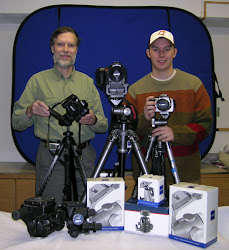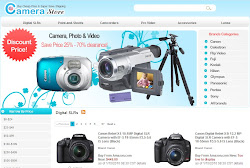Nikon officially introduced the 12.1 MP Nikon D700 FX format (equivalent to 35mm format) digital SLR on July 1st, 2008. The D700 is often said to be a "D3 in a D300 body". Take a D3, put it in a smaller body, do some clever cost-cutting but modest feature changes, lower the price to nearly a half, and you've got a D700. So, just how close is the D700 to the D300?
The D700 shares a number of features with D300. Both of them sport a powerful 51-point AF system, a high resolution 3in VGA monitor with Live View, the same 1005-pixel metering system, along with an HDMI port for connection to HDTVs - albeit using a mini-jack on the D700. Both of them are also tough, offering resistance to dust and moisture.
For the camera body, the dimension of D300 is approximately 147 x 114 x 74 mm (5.8 x 4.5 x 2.9 in), D700: approximately 147 x 123 x 77 mm (5.8 x 4.8 x 3.0 in). Without battery, the weight of D700 goes up 995g and the D300 is 825g. So the D300 is slightly smaller and lighter than the D700.
The Main difference between the two cameras is that the D700 uses a FX - full frame sensor and the D300 uses the DX - 1.5x cropped sensor. The D700 employs exactly the same 12.1 Megapixel full-frame CMOS sensor as the D3, which conforms to Nikon's FX format and deliver images with 4256 x2832 pixels when coupled with an FX-compatible lens. Like the D3, you can still use DX-format lenses, but with a cropped portion of the sensor, delivering 5 Megapixel images.
The viewfinder on the Nikon D700 features an eye-level pentaprism with high refraction index and provides 95% frame coverage with 0.72x magnification. It's not as accurate as the D300 or the D3 which both offer 100%.
Now let's talk about the sensor size. D700 uses a 36 x 24 size and pixel density is just 1.4MP/cm2 compared to the 23.6 x 15.8 Size and Pixel Density of 3.3MP/cm2. It means that technically the D700 should have cleaner file since the pixel density is almost half that of the D300.
Nikon D300 has 70-300mm VR lens and you effectively get a lens that has a 450mm reach at the telephoto end of the zoom range. This comes handy when you're shooting wildlife or sports where the subjects are far away. The same lens on the D700 would result in photos where the subject will not fill up as much of the frame as it would on the D300.
In a word, the Nikon D700 is basically a Nikon D300 sized version of the Nikon D3 digital SLR. The major advancements in performance and design that were first introduced with the Nikon D3 and D300 have been incorporated in the D700 along with a few differentiating features and functionality. But the D300 is much cheaper than the D700-nearly half of the D700's price. So whether it is worthy to upgrade your D300 to D700 depends on you needs.
Links : Cheap Clothing Optional Galleries Store Buy Furniture Stores







0 comments:
Post a Comment